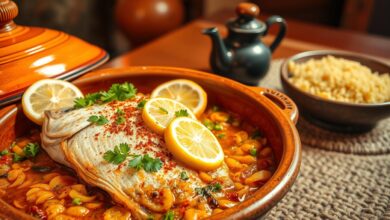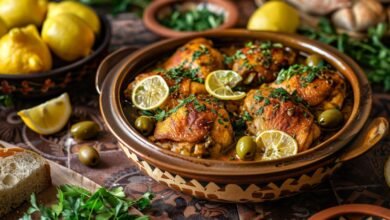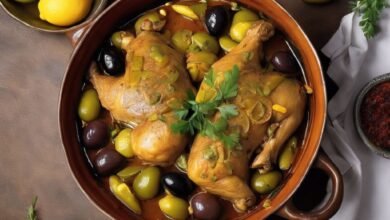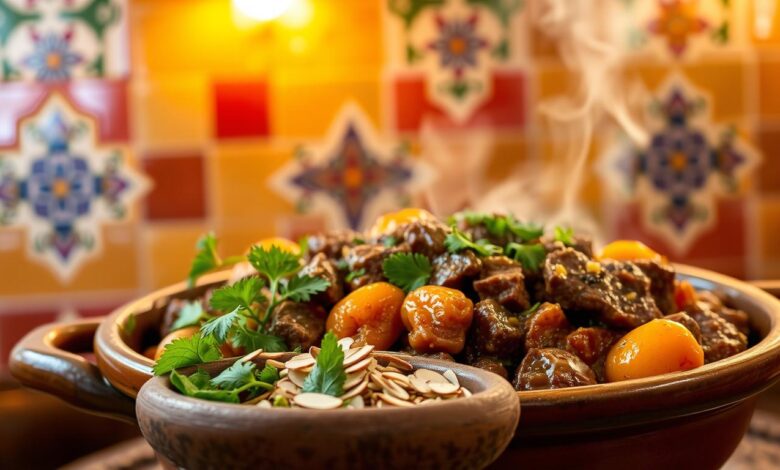
Imagine this: you set a heavy lidded pot on the stove, smell warm spices, and walk away to finish a book. Hours later, you return to a fragrant stew that turned tougher cuts into tender bites. It felt like a small, delicious miracle.
You learned that a classic cone-lidded vessel is optional; a sturdy Dutch oven recreates the same moist, self-basting environment. Slow simmering let the sauce concentrate and the meat relax into deep flavour.
The plan mattered. You prepped core ingredients—meat, dried apricots, tomatoes, chickpeas, and spices—so prep flowed and nothing slowed the cooking. You chose couscous cooked in broth and toasted almonds to add crunch and bright herbs for finish.
Key Takeaways
- Low-and-slow cooking transforms economical cuts into a comforting dinner.
- A Dutch oven works as well as a traditional pan for home cooking.
- Prep ingredients ahead to keep the recipe smooth and relaxing.
- Balance warm spices with fresh herbs and toasted almonds for texture.
- Plan sides like couscous so you can plate and serve immediately.
What Makes This Moroccan-Style Dish Special
What sets this Moroccan-style stew apart is how slow, low heat reshapes pantry staples into something rich and comforting.
The long simmer melts collagen in tougher cuts, so your beef becomes tender and silky. A warm mix of cinnamon, cumin, turmeric, and ginger builds a cozy spice backdrop that complements, not overwhelms.
Softened onion and garlic form a sweet-savory base. Tomatoes and stock add bright acidity while chickpeas give body and fiber. Dried apricots melt gently into the sauce, lending balanced sweetness alongside a drizzle of honey.
Why it works for home cooks
- Low, steady heat turns economical meat into a luxurious result.
- Many Moroccan recipes favor lamb, but beef keeps cost down without losing depth.
- A covered pot recirculates steam, keeping the stew moist and sauce silky.
In short: patient simmering and thoughtful spices create a dish that rewards time, improves after resting, and welcomes small tweaks to match your taste.
Beef Tagine with Apricots: Ingredients, Tools, and Smart Substitutions
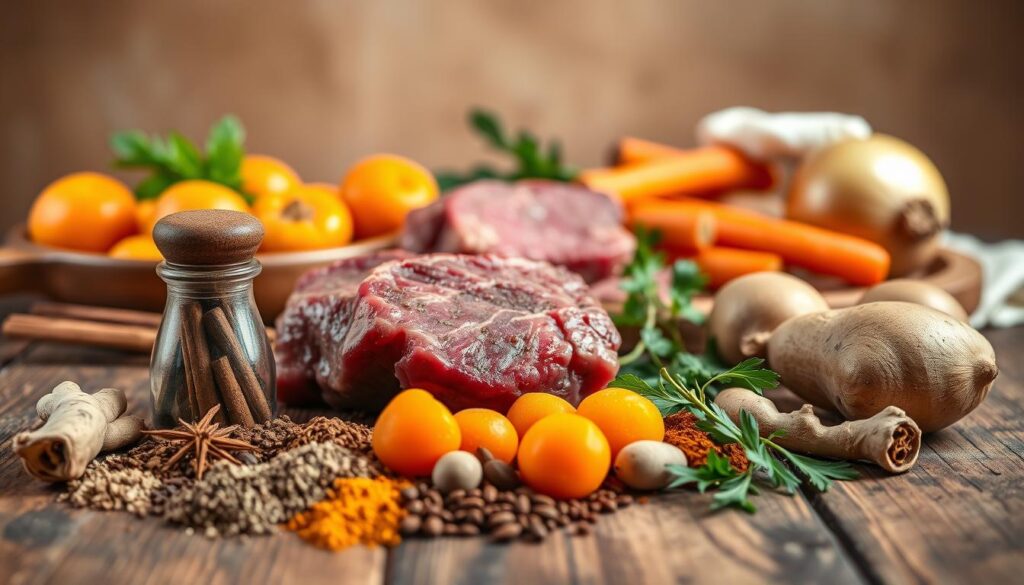
A smart mise en place makes the cooking easy and keeps flavors focused. Start by collecting the core ingredients so you can move through the recipe without pauses.
Core ingredients
Pick stew beef cut into 1.5-inch cubes, dried apricots quartered, a can of chickpeas, and peeled diced tomatoes. Keep chicken or vegetable stock handy to braise and finish the sauce.
Spice profile
Use cinnamon, ground cumin, turmeric, and ginger as the backbone. Add paprika or ras el hanout for color and depth.
Equipment and swaps
Choose a traditional tagine or an enameled Dutch oven with a tight lid to trap steam. Use a high-smoke-point oil to sear, and keep a bowl nearby for rested meat.
| Vessel | Heat behavior | Best use |
|---|---|---|
| Traditional tagine | Slow, even steam cycling | Authentic finish, gentle simmer |
| Dutch oven | Even conduction, retains heat | Reliable for searing and braise |
| Heavy lidded pan | Good steam retention, budget-friendly | Weeknight-friendly one-pot meals |
Easy add-ins: butternut squash, prunes, harissa for heat, toasted almonds, and chopped herbs at the end. These tweak texture and sweetness without extra fuss.
Step-by-Step: From Sear to Simmer for a Flavorful Tagine
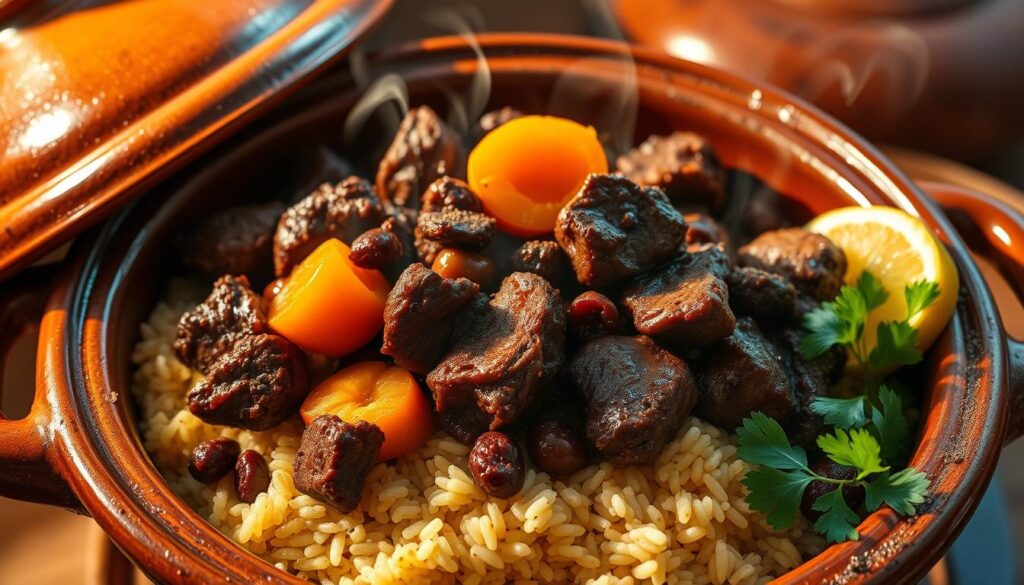
Begin at a hot pan so each cube forms a crust; that browning is the backbone of the finished stew. Pat the meat dry, season with kosher salt and black pepper, then brown in 2 tablespoons of olive oil for 10–15 minutes, turning until well colored.
Reduce to medium heat and add diced onion, carrots, and minced garlic. Cook 8–10 minutes until soft, then stir in ground ginger, cumin, and turmeric along with whole cinnamon sticks so the spice aroma blooms.
Return the seared meat, deglaze the pan with pomegranate juice or a splash of broth mixed with a little vinegar, then add diced tomatoes and chicken stock. Fit the lid and simmer gently for about 1.5 hours so the meat relaxes into tender bites.
Stir in quartered dried apricots and a touch of honey, cover, and cook 30 more minutes. Remove cinnamon sticks, add chickpeas, and season to taste.
If you prefer a thicker sauce, cook uncovered for roughly 30 minutes over low heat so steam escapes without boiling. Add a little water if the pan looks dry, or tilt the lid to speed reduction while protecting the bottom.
Serve it right
Pour boiling chicken stock over couscous in a bowl, cover for a few minutes, then fluff and fold in toasted almonds and chopped parsley. Or simmer brown rice and finish with coriander and pomegranate seeds for a jeweled side.
| Step | Time range | Key tip |
|---|---|---|
| Sear meat | 10–15 minutes | Use a wide pan and avoid crowding for deep color |
| Soften aromatics & bloom spices | 8–10 minutes | Reduce to medium heat to avoid burning ground spices |
| Low simmer | About 1.5 hours | Keep lid on; small lazy bubbles, not a boil |
| Add fruit & finish | 30–60 minutes | Cover first, then uncover to thicken if needed |
Conclusion
Making this recipe ahead rewarded you with deeper layers of spice and sweetness. The stew rested well and froze cleanly, so portioning saved time and kept dinners easy.
Plate the stew over fluffy couscous or jeweled brown rice so each grain soaks up the sauce. Finish with chopped herbs and a light dusting of cinnamon to brighten the dish.
Leave final salt and pepper adjustments until the end, after reduction concentrates flavor. Leftovers reheated into a fast, satisfying meal that proved some recipes improve with time.
You finished confident: the method scales, serves a crowd, and sets you up to revisit this apricot-forward approach whenever you want a warmly spiced dinner.
